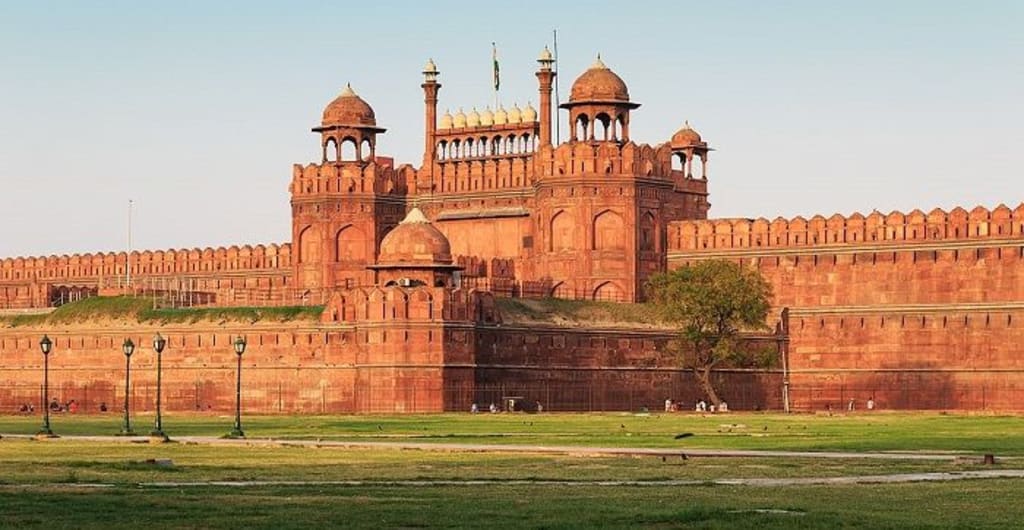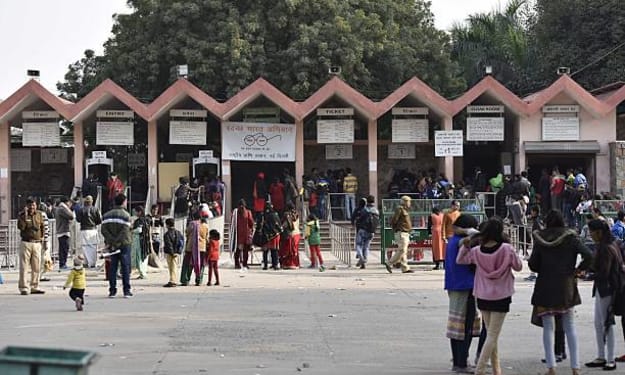Cultural India : Indian Forts : Red Fort Delhi
The Red Fort, which is also known as the Lal Qila, was constructed by one of the most famous Mughal emperors, Shah Jahan

Built on the banks of river Yamuna, the fortress-palace was designed by architect Ustad Ahmad Lahauri. It took 8 years and 10 months to build the magnificent fort. The fort served as the royal residence of the Mughal emperors from 1648 to 1857. It took over the honor of royal residence from the famous Agra Fort when Shah Jahan decided to shift his capital from Agra to Delhi. The Red Fort derives its name from the red-sandstone walls, which make the fort almost impregnable. The fort, which is located at Old Delhi, is one of the massive and prominent structures of India and is a fine example of Mughal architecture. It is often considered as the pinnacle of Mughal creativity. In modern times, the fort is of importance to the people of India as the Indian Prime Minister delivers his Independence Day speech from the fort, every year on August 15. In 2007, it was declared as UNESCO World Heritage Site.
History
Shah Jahan, the then Mughal emperor decided to build the Red Fort as the citadel of Shahjahanabad, his new capital at Delhi. The fort, which was completely constructed in the year 1648, remained the residence of the Mughal emperors until 1857. Post the reign of Aurangzeb, the Mughal dynasty grew weaker in every aspect and that started taking a toll on the fort. When Farrukhsiyar, the ninth Mughal emperor, took over the reign from Jahandar Shah after murdering him, the fort began to lose its luster, quite literally. During his reign, the silver ceiling of the fort was replaced with copper in order to raise money. This was probably the beginning of the plunder that would go on for years to come. In 1739, Nadir Shah, the Persian emperor defeated the Mughals and took with him some of the valuables belonging to the fort, including the famous peacock throne, which had served as the royal throne of the Mughals. The weakened Mughals had no other option but to sign a treaty with the Marathas, who had promised to protect them and the fort. In 1760, when Ahmed Shah Durrani of the Durrani dynasty threatened to capture Delhi, the Marathas dug out the silver ceiling of Diwan-i-Khas to strengthen their army. However, Ahmed Shah Durrani defeated the Marathas in the third battle of Panipat and took over the fort. The Marathas reconquered the fort in 1771 and stalled Shah Alam II as the 16th Mughal emperor. In 1788, the Marathas occupied the fort and ruled over Delhi for the next 20 years before the British defeated them during the Second Anglo-Maratha War in 1803.
The fort now was occupied by the British, who even built a residence of their own within the fort. During the Indian rebellion of 1857, Bahadur Shah II, was arrested by the British and later exiled to Rangoon. With Bahadur Shah II, the Mughal Empire came to an end and this opened a window of opportunity for the British to loot valuables from the fort. Almost all furniture were either destroyed or shipped to England. Many edifices and landmarks within the fort were destroyed and barracks of stone replaced them. Many priceless possessions like the Koh-i-Noor diamond, the crown of Bahadur Shah and the wine cup of Shah Jahan were sent to the British government. After independence, the Indian Army occupied a major part of the fort before handing it over to the Archaeological Survey of India (ASA) for restoration purposes.
Layout of the Fort
The Red Fort is spread across an area of 254.67 acres. The defensive wall, enclosing the fort, is measured at 2.41 kilometers. The walls differ in height as they stand at 18 meters on the river side as opposed to the 33 meter high wall on the city side.The fort rises above a wide dry moat in the northeast corner of the medieval city of Shahjahanabad.
The main entrance of the fort (Lahori Gate) opens at the ‘Chatta Chowk’, a covered street bordered with arched cells that used to house Delhi's most talented jewelers, carpet makers, weavers and goldsmiths.This covered passage was also known as the ‘Meena Bazaar’, which served as the shopping center for the ladies belonging to the court. The ‘Naubat Khana’ or the Drum House is situated a few meters away from the ‘Chatta Chowk’. The musicians would play for the emperor from the ‘Naubat Khana’ and the arrival of princesses and the royalty were heralded from here.
Towards the southern region of the fort stands the majestic Delhi Gate, which is similar in appearance to the main gate. The Red fort contains all the paraphernalia of the Mughal dynasty including the halls of public and private audience (‘Diwan-i-Am’ and ‘Diwan-i-Khas’), domed and arched marble palaces, plush private apartments, a mosque (Moti Masjid) and richly designed gardens. While the emperor would hear complaints of his subjects at the ‘Diwan-i-Am’, he held private meetings at the ‘Diwan-i-Khas’. The fort also houses the Royal Bath or the ‘Hammam’, the ‘Shahi Burj’ (Shah Jahan's private working area) and the famous Pearl Mosque, built by Aurangzeb. In the ‘Rang Mahal’ or the Palace of Colors, lived the Emperor's wives and mistresses.
The Red Fort was built by the legendary architect Ustad Ahmad Lahauri, who is believed to have built the world famous Taj Mahal. The fort is considered a creative structure and as the pinnacle of Mughal inventiveness. Red Fort has many structures that serve as fine examples of Islamic architectural style and Mughal architecture, which fuses the architectural styles of the Timurids and the Persians. The Red Fort is known for its gardens (most of which were destroyed by the British) and a water channel called the Stream of Paradise. This water channel connects many pavilions, an architectural style owned by the Mughals. This kind of architecture went on to inspire the construction of many edifices and gardens in the post-independence era. The fort was also embellished with floral decorations and precious ornaments. It is said that the Kohinoor diamond was part of the decoration that made the interiors look ostentatious.





Comments
There are no comments for this story
Be the first to respond and start the conversation.